Fundamental Principles of Olympism
Sport had always been and still is an important aspect of life in the Egyptian society. It is not a surprise that the Pharaonic History of being first movers to recognize that many of the sports we know & practice nowadays date back to ancient Egypt & the evidence on this are the paintings and scenes depicted on the walls of the temples & tombs all over Egypt.
Inscriptions on monuments indicate that the ancient Egyptians practiced wrestling, weightlifting, long jump, swimming, rowing, shooting, fishing and athletics, as well as various kinds of ball games and other sport activities. They even held many local and international sport festivals and competitions in which the best athletes from other countries participated and prizes were being given to the winners to encourage them and these competitions were governed by national and international judges from Asia and Africa. In addition, the rules followed in modern day sports are also mainly based on the ones practiced by the ancient Egyptians. All this explains the Egyptians unparallel passion for sport which is part of the national identity and cultural fabric of the Egyptian Society.
Gymnastics (floor exercise)
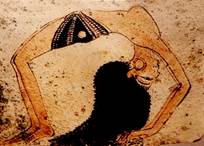
This picture dates back to 2000 years BC. It shows a gymnastics drill in which the body is bent backwards until the hands touch the ground, revealing bodily flexibility. It is one of the most commonly practiced exercises today
(Family 19) (1306-1186 BC)
Swimming
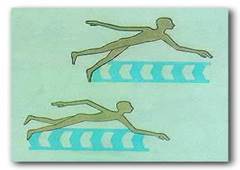

Swimming was the favorite sport of the ancient Egyptians who made use of the River Nile to practice it. The Nile was not the only place for swimming contests. Noblemen's palaces had swimming pools in which princes learned the sport. The calm waters of the Nile encouraged youth to hold swimming competitions in which they could show their skills
Boxing
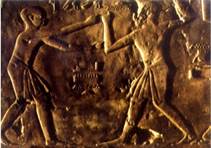
Some ancient Egyptian scenes of boxing as a sport were found in the tomb of "Mery Ra" in Minia Governorate and in the "Ptah Hotep" tomb in Saqqara. In this picture, a player is depicted in a position ready to direct his blows with his fist to another player, who in turn, tries to repel these blows
Hockey
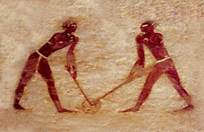
Ancient Egyptians played a game that is similar to our present-day hockey. Drawings on tombs at Beni Hassan in Menia Governorate show players holding bats made of long palm-tree branches, with a bent end similar to that of the hockey bat. The hockey ball was made of compressed papyrus fibers covered with two pieces of leather in the shape of a semi-circle. The ball was dyed in two or more colors
Rowing
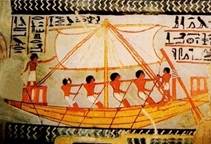
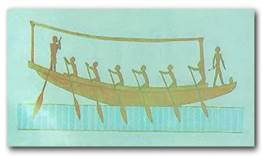
Rowing was one of the sports that required most physical strength on the part of the ancient Egyptian. Plates recorded team-rowing in which the players depended on harmonizing their rowing according to the directives of their leader who held the rudder. The leader also controlled their movement through a high-pitched systematic call to unify the moment when oars touched the surface of the water and that helped to push the boat forward more steadily and swiftly - a method still being adopted in rowing nowadays
Handball
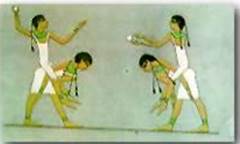
Drawings of this sport are found on the Saqqara tombs, five thousand years old. The ball was made of leather and stuffed with plant fibers or hay, or made of papyrus plants in order to be light and more durable. The painting shows four girls playing handball. This picture also proves that women used to practice sport just like their male counterparts, something which is highly encouraged and thought after in our modern times
Javelin Throw
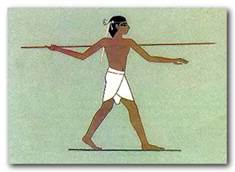
Javelin throwing during the Pharaonic age was first linked to hunting. The javelin differed in length according to the kind of prey. The picture shows the player in a position of readiness to throw.
Gymnastics (Consecutive Vault)

This painting represents pharaonic gymnastics. The players performed consecutive vaults without touching the floor with their heads and making more than one complete turn in the air. At the end of the exercise the players stand firmly upright, which is one of the basic rules of floor exercise applied in today's Olympics
Fishing
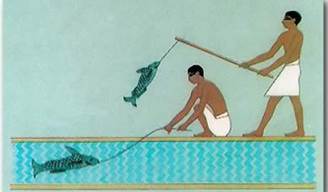
Fishing was one of the sports practiced by kings, princes and commoners. There are many drawings of scenes of fishing as a hobby on the Saqqara tombs. The Egyptian Museum comprises many kinds of fishing rods and hooks, which indicate the advance of such a sport in ancient Egypt
Weightlifting
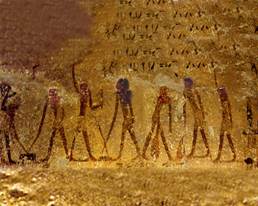
Weightlifting was one of the sports known by the ancient Egyptians. One method of weightlifting was the attempt to lift a heavy sack of sand with one hand (clean and jerk lift) and keep it high in a quasi-vertical position. The player had to stay in that position for a short period. This is one of the rules of weightlifting applied till now
Equestrian Sports
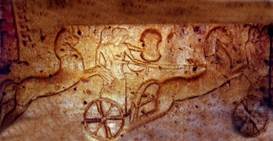
Horsemanship moved from the world of wars and war-chariots to that of sports and the chasing of wild animals. Ancient Egyptians held horse races among youth. They managed to stay on horseback without saddles in full control of the horse, as seen in this picture of an ancient Egyptian horseman.
High Jump
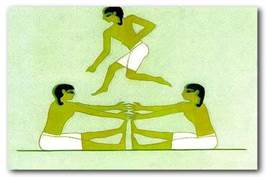
Ancient Egyptians practiced field and track sports such as the high jump as shown in this picture.
Archery
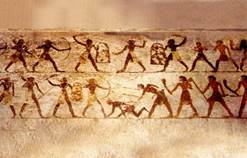
Archery was a well-known sport in Ancient Egypt and was often recorded on plates in ancient temples. These plates show the kings' and princes' skill in accurate aiming at the target, and their strength in pulling the bow. Archery competitions were common.
Tug of Hoop
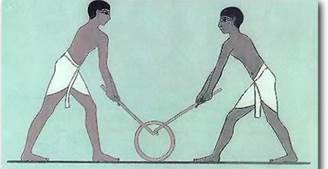
This is an ancient Egyptian game in which two players compete in pulling the hoop swiftly. Each contestant fixes a hooked staff to hinder any snatch of the hoop by the other player. This game needs sharp physical maneuvers and strict observation
Marathon
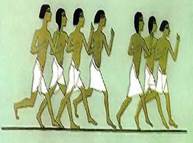
Marathon races were of the utmost importance in ancient Egypt, particularly during celebrations marking the assumption of power of new kings. One of the rituals of these celebrations was to hold a marathon run by the king around the temples before spectators to reveal his physical strength and his ability to rule using his bodily as well as mental capabilities. History records that the Pharaoh, together with those who were born on the same day of his birth, participated in hectic marathons.
Equilibrium
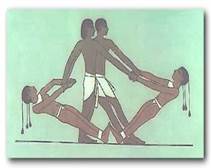
The picture represents equilibrium of two players opposite each other standing on their heels, their bodies stretched in a slanting position while holding hands with two other players. The four players turn round and round while maintaining their positions in perfect equilibrium and harmony of movement.
Tug of War
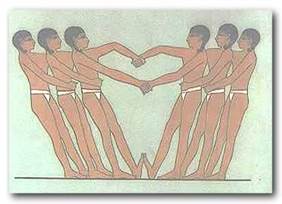
One of the ancient Egyptian plates at the "Marorika tomb" shows teams standing in two opposite rows, with the first players of each row holding hands and pulling back each other while the other members of each team hold each other tightly by the waist and try to pull back the opposite team.
Fencing
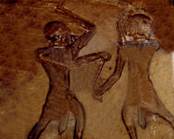
Fencing is a purely Egyptian sport. This picture shows two players holding weapons and wearing masks like the masks used for fencing nowadays.
Pierre de Coubertin
"The important thing in the Olympic Games is to participate. The most important thing in life is not to win in spite of everything. The most important subject is having struggled in the best way. If we spread this and have this adopted as necessary, we shall have created a more powerful, more courageous and most important of all, more ethical and more generous mankind . " Baron Pierre de Coubertin
The founding father of the modern Olympic Games, Pierre de Coubertin, was born on 1 January 1863 in Paris to a noble French family. Coubertin was very well educated and he had many hobbies such as horse riding, rowing, boxing and fencing. He believed that practicing sport would strengthen his body; he also played the piano and used to write memoirs. Although Coubertin was known to be an aristocrat, he established communication with farmers and villagers whenever an opportunity arose. Coubertin was interested in "Education and Sport" and in 1883, when he was 20; he traveled to England where he made researches on pedagogy. In 1889, he went to the United States and when he came back to France he started publishing "Athletics" and "Athletic Sports" magazines.
Meanwhile, the French Societies of Athletics Sports (USFSA) was founded to manage athletic sports and Pierre de Coubertin became its Secretary General. During the fifth anniversary meeting of USFSA which took place in Sorbonne on 25 November 1892, de Coubertin made a speech entitled "Physical Training in the Modern World", in this speech he was talking about "the restarting of the Olympic Games" for the first time.
Thus, a commission under the chairmanship of Baron Pierre de Coubertin was formed in order to restart the Olympic Games and to form the International Olympic Committee (IOC). It was decided to make a congress where Olympic principles would be discussed and on 16 June 1894 a total of 2000 people convened in "Sorbonne Congress".
On 23 June 1894 the "Citius, Altius, Fortius" (Faster, Higher, Stronger) was introduced by Baron de Coubertin and it became the first official Olympic motto.
After seeing his dream come true, de Coubertin voluntarily stepped down from IOC presidency at the IOC Session held in Prague in 1925 after spending his entire fortune on the Olympic Games, Olympic Movement and Olympism. He spent the rest of his life in making researches about pedagogy, scientific studies and writing his memoirs.
Baron Pierre de Coubertin remained as the honorary president of the IOC until his death in Geneva on 2 September 1937.
Fundamental Principles of Olympism
1. Olympism is a philosophy of life, exalting and combining in a balanced whole the qualities of body, will and mind. Blending sport with culture and education, Olympism seeks to create a way of life based on the joy of effort, the educational value of good example, social responsibility and respect for universal fundamental ethical principles.
2. The goal of Olympism is to place sport at the service of the harmonious development of humankind, with a view to promoting a peaceful society concerned with the preservation of human dignity.
3. The Olympic Movement is the concerted, organised, universal and permanent action, carried out under the supreme authority of the IOC, of all individuals and entities who are inspired by the values of Olympism. It covers the five continents. It reaches its peak with the bringing together of the world’s athletes at the great sports festival, the Olympic Games. Its symbol is five interlaced rings.
4. The practice of sport is a human right. Every individual must have the possibility of practising sport, without discrimination of any kind and in the Olympic spirit, which requires mutual understanding with a spirit of friendship, solidarity and fair play.
5. Recognising that sport occurs within the framework of society, sports organisations within the Olympic Movement shall have the rights and obligations of autonomy, which include freely establishing and controlling the rules of sport, determining the structure and governance of their organisations, enjoying the right of elections free from any outside influence and the responsibility for ensuring that principles of good governance be applied.
6. Any form of discrimination with regard to a country or a person on grounds of race, religion, politics, gender or otherwise is incompatible with belonging to the Olympic Movement.
7. Belonging to the Olympic Movement requires compliance with the Olympic Charter and recognition by the IOC. (Olympic Charter, 2015)



















